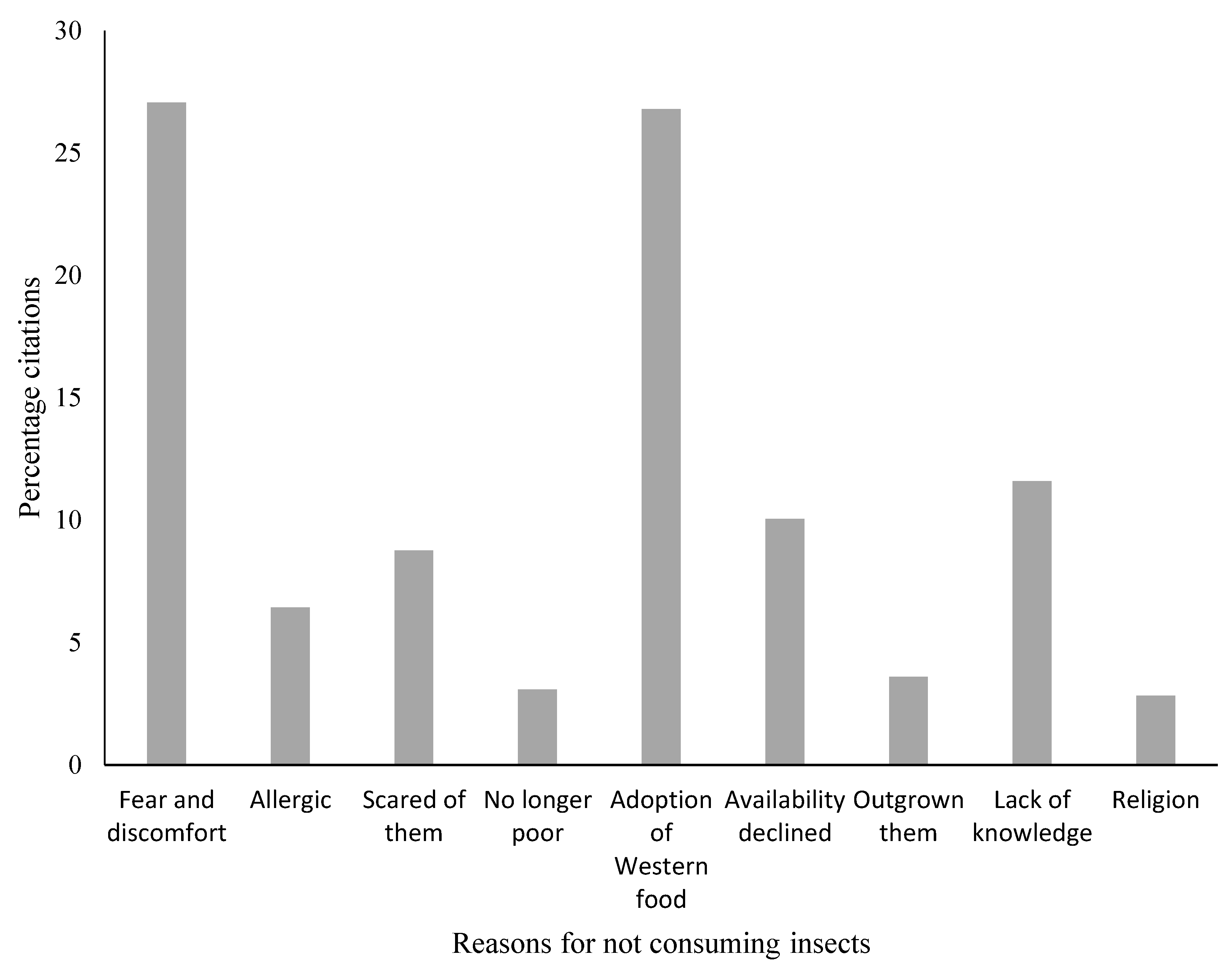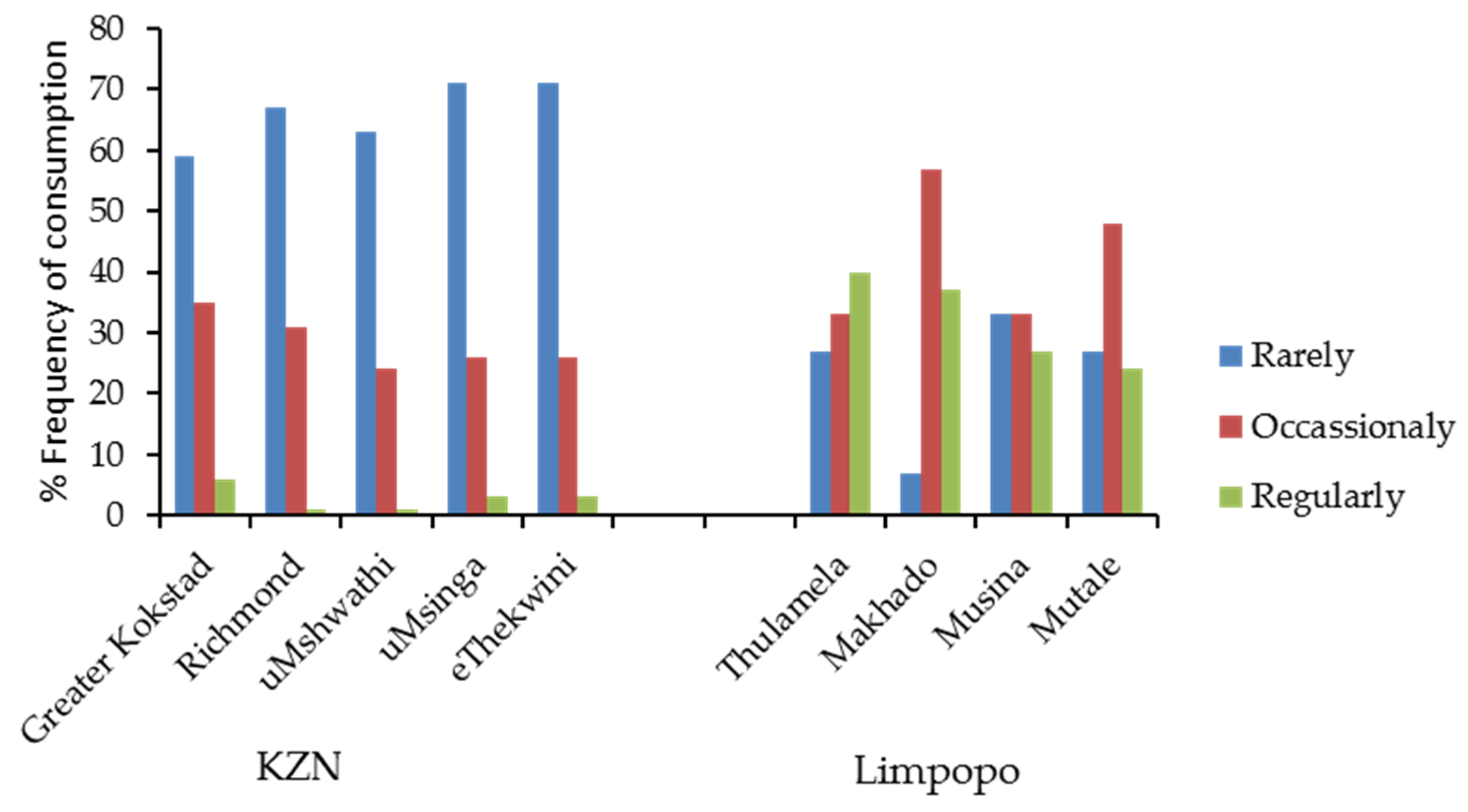1. Introduction
Entomophagy is an ancient indigenous practice that has played a significant role in human nutrition around the world [
1,
2]. Edible insects are an important protein source, and their consumption plays an important role in food security and improving rural livelihoods [
2,
3,
4,
5]. They are consumed as a traditional food in different regions, including Latin America [
6], China [
7,
8], Thailand [
1,
9], Mexico [
10,
11], Japan [
12,
13], and Africa [
14,
15,
16,
17,
18,
19,
20,
21,
22]. The traditional use of insects as food in these countries is not a new practice, as it dates back as far as the history of mankind [
10,
11,
12]. However, consumption of insects is not well accepted in western countries and still remains unexplored, because of barriers such as fear and disgust associated with eating insects [
23,
24,
25,
26]. In addition, in developed countries, eating insects is considered primitive, unclean, or food of the poor [
24]. In Africa, approximately 500 species of insects are used as food in different countries [
5,
27]. On this continent, edible insects are consumed either as a staple, an emergency food source during times of food shortage, or an important delicacy [
22,
28]. Consumption and preference of edible insects differ geographically [
22]. For example, some people prefer consuming insects, either fried, roasted, or raw, and others may find eating insects disgusting [
5,
14]. In some African countries, certain species are only consumed in one region and are of traditional importance; for example, stink bugs (Hemiptera: Tessaratomidae) are only consumed and are a delicacy for the vhaVenda people in the Limpopo province of South Africa [
15].
In South Africa, edible insects have formed part of the human diet since prehistoric times; for example, Ledger [
29] reported that South Africans consumed
Trinervitermes trinervoides (a termite) and
Apis mellifera unicolor (a honeybee) in early 100,000 BCE. In addition, Quin [
20] and Bodenheimer [
30] reported an ongoing consumption of edible insects for nutritional benefits by the baPedi people in South Africa in the early 1950s. Nowadays, in South Africa, edible insects are mostly consumed in Limpopo province by vhaVenda, baPedi, and Vatsonga people [
13,
15,
31]. In addition, they are also consumed in Mpumalanga, KwaZulu-Natal [
32], North West, and Gauteng [
15]. The groups of edible insects consumed in South Africa are various Lepidopteran caterpillars, termites, grasshoppers, jewel beetles, ants, and stink bugs [
13,
15,
29,
33]. Edible insects are an important natural resource available to vulnerable people and provide earning opportunities to traders and harvesters [
31,
34,
35,
36,
37]. In addition, edible insects play an important role in food security, rural livelihoods, and poverty eradication [
34]. For example, Makhado et al. [
33] reported that trading edible insects results in an income of approximately US
$202,915 per trader during one season. Edible insects create seasonal employment opportunities for unemployed people across southern Africa, reducing poverty and improving human wellbeing [
31,
34].
Malnutrition and food shortage are the major challenges experienced in developing countries [
38]. According to Voster [
39], most people in South Africa are food-insecure and do not have access to nutritious food to meet their daily nutrient requirements. Edible insects are consumed because they are a nutritious traditional food source that has been used to supplement diets across Africa over many years [
22]. In addition, consumption of insects is good for human wellbeing, as the nutritional value of edible insects can help promote human health, and reduce the vulnerability to malnutrition of children, pregnant women, and older people [
40]. Edible insects can also improve the well-being of vulnerable people living with malnutrition, child stunting, and macronutrient deficiencies [
41,
42,
43,
44].
Over the years, there has been a notable decrease in entomophagy in developing countries, particularly in urban areas [
4,
21]. The younger generation, especially in urban areas, has little or no knowledge about insects’ consumption [
4]. This is thought to result from people adopting western/modern food culture and, therefore, abandoning traditional practices such as entomophagy [
4]. Globalization and westernization have influenced what people eat [
23]. As a result, people are more reliant on western food, and they are more reluctant to try traditional food such as edible insects, as they are now perceived as dirt or a taboo [
4,
23,
44]. This has led to several people being wary of accepting insects as food or even distancing themselves from consuming insects [
4,
23,
45]. Yet, edible insects are rich in protein, carbohydrates, amino acids, and micronutrients, such as zinc and iron [
5].
Little attention has been paid to documenting indigenous knowledge on insects’ consumption as an important traditional practice in South Africa [
46,
47,
48]. The traditional understanding of entomophagy among indigenous people is rich but restricted because it is orally passed through generations, and some has been lost in translation over the years [
1,
49]. Mostly, rural communities have no tools or resources to document their indigenous knowledge about practices that play an important role in their communities. As a result, indigenous knowledge is lost because recent generations have adopted western methods and paid less attention to traditional practices [
4,
50]. Combining indigenous knowledge about entomophagy with scientific research will further improve the understanding of the role of edible insects as a food resource for people [
49]. In addition, documenting indigenous knowledge about edible insects will help promote and preserve entomophagy [
4]. The current study, therefore, aims to (1) document indigenous knowledge relating to the consumption patterns, methods, or techniques used in the collection, and preparation of insects in South Africa; (2) determine the most consumed or preferred insect species; (3) access the perception of edible insects; and (3) determine the factors influencing the consumption of edible insects in South Africa.
4. Discussion
Entomophagy is an important traditional practice in Africa’s different regions [
4,
46]. The current study reported a greater number of respondents consuming insects in their lifetime in Limpopo (98%) and KwaZulu-Natal (64%). These results are similar to those of Shackleton et al. [
32]. They reported that 96.3% of the respondents in Ha-Gondo village, 55 km east of Thohoyandou in Limpopo, used insects as food; by comparison, 67.8% of the respondents in KwaJobe village in northern KwaZulu-Natal used insects as food. These results indicate that entomophagy is a common practice in South Africa. In addition, Egan [
49] reported that 90.5% of the respondents consume insects in Blouberg Municipality in Limpopo. According to Teffo et al. [
15], the consumption of insects in South Africa is more prevalent in Limpopo, Gauteng, North West, and Mpumalanga provinces. Across African countries, Zimbabwe [
4,
5,
6,
7,
8,
9,
10,
11,
12,
13,
14,
15,
16,
17,
18,
19,
20,
21], Angola [
54], Tanzania [
36], Nigeria [
55], and Botswana [
18] have been reported to consume edible insects. However, Ethiopia is one exception, because religious beliefs prohibit the consumption of insects, and only 1% of people interviewed were prepared to accept insects as a human food [
56].
However, the consumption of insects may be declining in some areas, as reported in the current study; only 28% still consume insects in KwaZulu-Natal. According to Doberman et al. [
57], the consumption of insects seems to be declining because of the spread/adoption of western food choices, and the association of insects with fear and discomfort when it comes to eating them. In addition, the way of living is constantly changing, and is being influenced by modern technology and education, resulting in people neglecting traditional practices that formed part of their lifestyle in the past [
50,
58]. Documenting indigenous knowledge about edible insects will preserve long-standing traditional knowledge about edible insects that can help influence planning and decision-making on the sustainable use of insects as a nutritious food that can ensure food security for people in developing countries [
50,
59].
The choice not to eat insects is primarily influenced by preference, availability of insects, and consumer acceptance [
60]. Findings from the current study revealed that religion (for example, the “African-initiated church” such as the Zionist churches) and fear associated with consuming insects were the main reasons influencing the decision not to eat insects. According to van Huis [
61], the consumption of insects is perceived as unholy, dirty, and unhealthy by some people, particularly in developed countries. For example, Balzan [
24] reported that, in Italy, respondents associated insect meals with dirt and food contamination. In addition, Netshifhefhe et al. [
31] found that 80.7% of the respondents in Limpopo cited that some religions are against the consumption of insects, especially traditional churches. Culture plays a significant role in determining acceptance and preference of edible insects. For example,
Zonocerous spp (a grasshopper) is consumed as food in Cameroon, Nigeria, and South Africa, but the same species is considered poisonous elsewhere [
62]. In addition, cultural beliefs influence how insects should be prepared before consumption [
62]. Religious and gender-based taboos also govern the consumption of insects in some regions. For example, religion and customs prohibit women of the Baganda tribe in Uganda from consuming nsenene (
Ruspolia differens) [
36,
62]. There is a need to educate and raise awareness about the consumption of insects through media to promote and encourage people to adopt edible insects as foods, because insects are a sustainable nutritious food which has less impact on the environment [
58]. In addition, incorporating insect powder into food products such as bread, biscuits, snack bars, cereal, porridge, and shakes might promote acceptance of insects as food [
60].
Sociodemographic factors play a significant role in a person’s choice to consume insects [
63]. This study found that gender, age, occupation, and educational background were the main factors influencing the choice to eat insects. These results are similar to Anakware et al. [
64], a study which found that gender, age, educational background, and occupation significantly influenced people’s choice to consume insects in Ghana. Youth, educated, urban dwellers, and middle- and upper-class earners are highly influenced by western culture [
65]. As a result, they are adopting western diets and ignoring traditional food such as edible insects. There is a notable shift to adopting Western diets, and a decline in consumption of edible insects, particularly by youth and educated people [
65]. This might be the main reason why the consumption of insects is largely practiced in rural areas where high levels of unemployment and people with no formal education are found. In addition, people who are unemployed consume edible insects more because they have to do so to meet nutritional requirement needs.
Eight insect species belonging to five insect orders were used as food in Limpopo and KZN. These results are similar to Obopile and Seeletso’s [
18] findings, who reported that insects belonging in six insect orders were used as food in Botswana. Contrary to this, Makhado et al. [
33] reported that insects belonging in four insect orders were used as food in Greater Giyani Municipality, Limpopo. This suggests that the consumption pattern and preference of insects vary from place to place [
66]. According to Raheem et al. [
1], insects and preference consumption varies from country to country, and variations can be observed between ethnic groups in different countries. The variation in the number of insects consumed in different countries is attributed to the availability and occurrence of edible insects in the wild [
62]. Differences in geographic area and environmental conditions influence the occurrence of different species; for example, mopane worm (
Imbrasia belina) occurs in mopane woodlands in Southern Africa and is mostly used as food in this region [
67].
Mopane worms and termites were the most preferred and consumed insects in Limpopo and KwaZulu-Natal, respectively. Kelemu et al. [
27] reported that mopane worms and termites are the most consumed species in Southern Africa. In addition, they are a popular traditional food in many cultures in Southern Africa [
31,
68]. According to Baiyegunhi et al. [
68], mopane worms are occasional delicacies for different cultures in South Africa. Edible insects are valued natural resources that people collect for food and income in rural areas; they are used as a food security safety net in rural areas where poverty and malnutrition are major problems [
33,
67,
68].
This study found that edible insects are consumed because of their nutritional value and they contribute to nutritional diets in rural areas. Similar results were reported by several previous studies [
4,
15,
31]. Netshifhefhe et al. [
31] conducted a study looking at the human uses and indigenous knowledge of edible termites in Vhembe district, Limpopo province, South Africa, and found that the majority of the respondents consumed edible termites for their nutrition and to enhance their health. Similarly, Manditsera [
4] conducted a study on consumption patterns of edible insects in rural and urban areas in Zimbabwe and found that the primary motives for consuming insects in rural and urban areas were nutrition and taste of edible insects. Food shortage and malnutrition are prevalent challenges experienced in rural communities in Southern Africa [
38]. Edible insects play an important role in supplementing diets in poor communities across Africa [
46]; in addition, edible insects are used to ease food shortages and provide vulnerable communities with nutritious diets that improve human health and wellbeing [
69,
70].
Climate change is a global problem that reduces precipitation and increases the extended drought in Southern Africa [
71,
72]. These changes have resulted in the decline of insect availability in the wild [
71,
73]. Other factors that might affect the availability of edible insects are different land uses such as clearing of land, development, agriculture, and deforestation [
61,
70,
72]. Ndlovu [
72] reported that 40% of the respondents in Zimbabwe cited that the cutting down of mopane trees for fuel use resulted in the decline in mopane worm yields. The decline in the availability of insects affects rural livelihoods and the well-being of the people who depend on insects for food and cash income [
61,
71]. In addition, this affects the nutrition security of rural populations. Interventions to increase insect yields are required. This can be done by farming and rearing to make insects easily available to people, particularly in vulnerable communities [
61,
70,
71]. In addition, because of their nutritional value, insects can be used as nutritious food alternatives to mainstream animal protein such as pork, chicken, beef, and fish [
61,
70,
71,
74].
Insects are mainly harvested in the wild by women. According to Dzerefos et al. [
75,
76], insects collection and preparation are primarily female-driven tasks, with more than 70% (in the current study) of females involved in insects harvesting in Limpopo province. Insect preparation and processing methods differ from species to species. The important step is removing unpalatable parts and degutting before washing [
77,
78]. After washing, insects are then boiled or roasted, then sundried to increase shelf life [
79,
80]. According to Agea et al. [
28], sun-drying insects extend the availability of insects and allows traders to have products for a longer period, even when the period of occurrence of insects has passed.
This study reported that edible insects are incorporated in regular diets and they are eaten fried, boiled, roasted, dried, or as a relish. Similar findings were reported by other authors [
4,
21,
31,
81]. They found that edible insects are eaten fried, boiled, dried, or as a relish. However, in some parts of Africa, edible insects are smoked or eaten raw without preparation [
66,
82]. Tradition and culture influence cooking methods of edible insects. People prepare insects based on the knowledge that has been passed down from older generations; for example, in Limpopo province, South Africa,
Encosternum delergorguei (stink bug) is eaten either fried or raw, while in Zimbabwe, the same species is eaten fried or dried but not raw [
15,
21]. In addition, some tribes prohibit the consumption of raw edible insects; in Uganda, the Baganda tribe customs and tradition prohibit the consumption of raw
Ruspolia differens [
36]. Cooking methods improve the sensory quality of edible insects through the formation of aromatic compounds [
83]. According to Gosh et al. [
62], sensory characteristics such as taste, texture, odour, colour, and appearance play an important role in food selection, acceptability, and preference. Some cooking methods reduce foodborne and degradative enzymes, which increase the shelf life of edible insects [
83].
This study’s limitations were that local communities refer to several species from one insect order/genus using the same common vernacular names. Therefore, there might be an underrepresentation of the total number of species consumed in the two provinces. Respondents relied on the pictures from the insect guidebook to identify the correct species they consume; species that were not represented in the book might have been left out of the survey.









